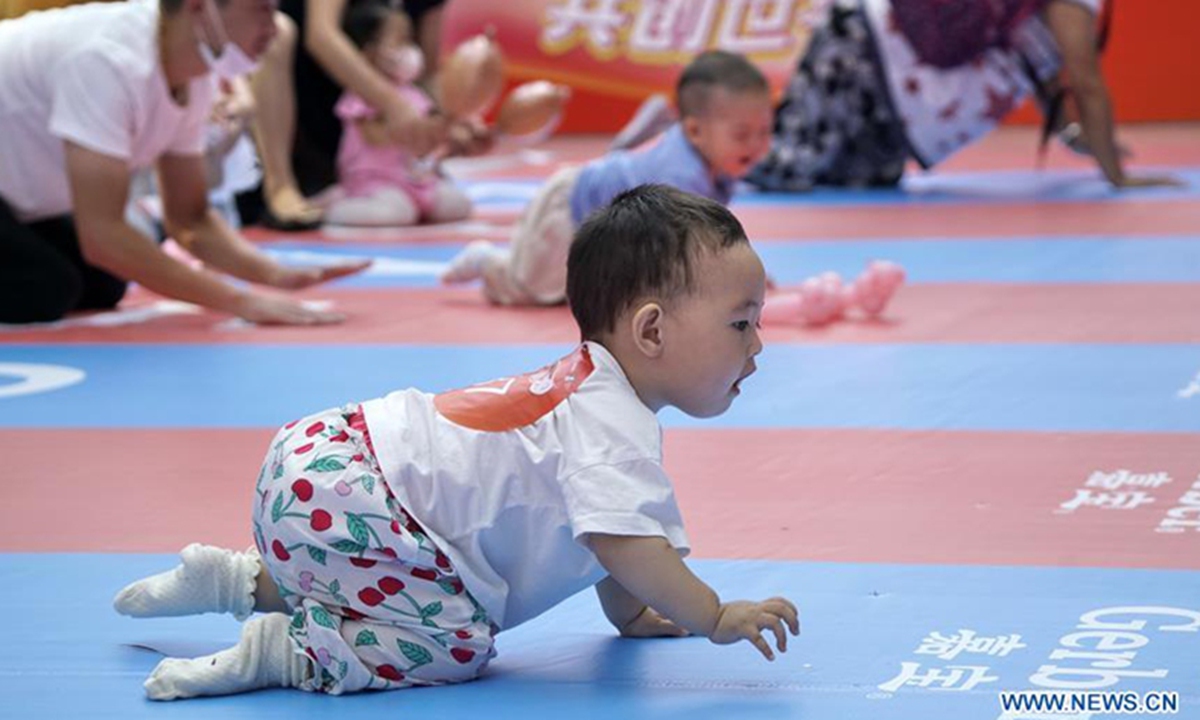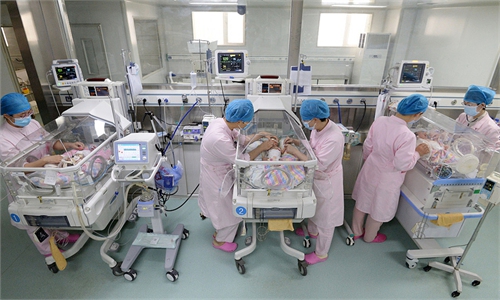China's human resources continue to rise, expected to support high growth potential across nation's economy by 2050: economist

Babies participate in a baby crawling contest at a shopping center in Daxing District, Beijing, capital of China, Sept. 13, 2020. (Xinhua/Li Xin)
As the trend of declining population in recent years has raised public concern over the country's social vitality, a prominent Chinese economist said at a forum that China's total human resources will continue to rise and gradually stabilize by 2050, and is expected to support relatively high growth potential across the Chinese economy between 2022 and 2050. The expert also noted that the faster peak in population growth and a rapidly aging population will not affect the potential of the country's economic development.
According to a latest survey released at the forum, China is currently experiencing a double transition of population and family, with a low fertility rate and an obvious trend of smaller family sizes.
The survey was released by the third China Population and Development Forum, hosted by the China Family Planning Association, Committee of Population, Resources and Environment of the Chinese People's Political Consultative Conference National Committee and China Population and Development Research Center, in Beijing on Saturday.
According to the survey, the average household size dropped to 2.62 people in 2020, 0.48 fewer than that in 2010. The number of children a woman has now dropped from 1.63 in 2019 to 1.19 in 2022. Delayed marriage and childbearing, non-marriage infertility caused by the changes of family concept have become the most important factors behind declining fertility levels in China.
The average age of first marriage for women rose from 22 in the 1980s to 26.3 in 2020, and the age of first childbearing has been pushed back to 27.2.
The fertility intention of couple of childbearing age continues to decline. The average number of children they intend to have in 2021 is 1.64, down from 1.76 in 2017 and 1.73 in 2019, while the number of "post-1990s" and "post-2000s," as the main fertility subjects, is only 1.54 and 1.48.
Lifetime childlessness among women is rising rapidly, from 6.1 percent in 2015 to nearly 10 percent in 2020.
Wang Pei'an, Party Secretary and executive vice president of China Family Planning Association, suggested at the forum giving full play to the leading role of the new marriage and childbearing culture, advocating age-appropriate marriage and childbearing, and encouraging couples to share child-rearing responsibilities.
He also suggested implementing an annual leave system, gradually adjusting and shortening working hours, introducing flexible working hours, and providing more support for family life and leisure travel.
"We should vigorously develop the homemaking, aged care, and childcare industries, and continue to empower and enhance the efficiency of family construction, so as to raise the level of services for childbirth and continue to improve the quality of the newborn population," Wang said.
He also noted that, the family should be regarded as the basic unit of public policy, and the orientation of protecting marriage and family and encouraging family members to reunite should be fully reflected in the policies in such fields as urbanization, household registration reform, employment, medical care, pension, social security, housing and taxation.
In response to some pessimistic claims over the low birth rate as well as the aging of the population, Li Daokui, Mansfield Freeman Chair Professor of the Department of Finance of the School of Economics and Management of Tsinghua University, believes that there are a series of misunderstandings and misinterpretations in the economic circle and even broader society. Such views as "aging affects aggregate economic demand," "working-age population keeps decreasing" and "aging affects social innovation vitality" do not stand up to scrutiny, Li noted.
These misunderstandings arise because the society does not carefully distinguish between the concepts of total population and human resources. The core factor affecting the economic development of a country or a region is not the total population or the total number of young people, but the total number of active, healthy and skilled people who are willing to participate in social and economic activities, Li said.
The average life expectancy of Chinese society is constantly increasing, and the educational level of the population is constantly improving. The total amount of human resources is the sum of reserves taking into account population quality and future social labor time, the expert added.
The total potential of human resources depends specifically on two factors, the level of health and the level of education. Based on these two factors, Li's team measured the development trend of China's total human resources.
Studies by Li's team have shown that although the country's total population has reached its peak and the peak of total labor force participation has long passed, China's total human resources will continue to grow before 2040 and will remain stable from 2040 to 2050 thanks to increasingly levels of both health and education.
If 2020 is used as the base year and the total human resources are converted into population equivalent, compared with 1.4249 billion in 2020, the total human resources in the country will rise to 1.644 billion in 2050, an increase of about 15.4 percent. From 2021 to 2050, the average annual growth rate of the country's total human resources will reach 0.48 percent.
The studies estimate that if the country's human resources can be effectively promoted and fully utilized, the average growth potential of China's economy will reach 5.9 percent in 2021-2030, 4.9 percent in 2031-2040, and 4.1 percent in 2041-2050.
As China has proposed to basically realize socialist modernization by 2035, and to reach the level of moderately developed countries in terms of per capita income. Like reaching the level of Portugal, in fact, a growth rate of 4.61 percent is sufficient.
So, how to unleash the total potential of human resources? Li raised three strategies.
First, we should adjust social security, design a fair and reasonable pension replacement rate and payment rules, and form positive incentives.
Second, the key to education reform is not only to increase the number of years of compulsory education, but more importantly, lifelong learning.
Third, we need to improve the health of the whole people, especially the middle-aged and elderly people. We need to help them continue to be active in various social and economic fields.
"As long as we get the reforms in place, there is no need to worry about the negative impact of a declining population. Don't focus on the fertility rate, which is hard to change. If we can cope with it properly, Chinese modernization can overcome these two difficulties through a series of reforms. The key is to improve and make good use of human resources, and to become a power in human resources, which is my core point of view," Li said.
Global Times

